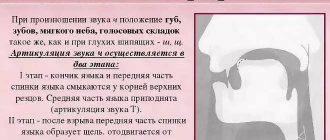Produces a strong and long-lasting air jet
An important role for setting the sound [P] is played by the correct setting of fixed breathing.
A strong, targeted air stream should pass through the articulatory organs. This means that you need to teach your child to breathe and speak correctly at the same time. Often this is not so easy to do. With the help of the following series of exercises, you will understand how to correctly position your tongue followed by the development of a targeted air stream in the middle of the tongue: 1. Place your tongue in the “Pancake” position (see description above) and blow forcefully on it with your voice turned on. When the air vibrates, the tongue will vibrate.
2. “Snowflake”: place a small piece of cotton wool on the tip of your nose and take a deep breath through your nose. Place the tongue in the “Spoon” position (see description above). We press our tongue to the upper lip and forcefully exhale air from the mouth onto the tip of the tongue. A piece of cotton wool should fall off your nose.
3. We bring a scrap or piece of paper to our nose and aspirately pronounce the sound [D]. When pronouncing each sound [D], a piece of paper should be shaken by a strong stream of air.
Preparatory stage
To prepare the speech apparatus, articulation and breathing exercises are used. In individual lessons with the child, the correct pronunciation of the sound “R” is discussed:
- lips are open;
- teeth are open;
- the back of the tongue is raised and slightly pushed forward;
- the tip rests on the alveoli and vibrates.
To facilitate perception, graphic pictures are used. All exercises from art. gymnastics are performed in front of a mirror. The complex is aimed at practicing the lifting and movements of the tip of the tongue.
“Horse” - with your mouth open, click your tongue, it is important that the jaw does not move. “Painter” - move the tip of the tongue from the alveoli of the upper teeth to the palate. “Mushroom” - the mouth is open, the wide tongue is tightly glued to the palate and held. From this position, an “Accordion” is made - the lower jaw lowers and rises, the tongue remains in the same place.
Exercises are done every day. The speed of production and sound automation depends on this.
To create vibration, do breathing exercises. A piece of cotton wool is placed on the tip of the nose, a wide tongue sticks out, assumes a “cup” position, and the cotton wool is blown off.
It is useful to blow away paper balls, plumes, and wind blowers. This needs to be done every day, several times. It is important to control the child so that he does not puff out his cheeks.
It is impossible to define clear deadlines for completing the preparatory stage. With dyslalia, it will take from a month to a year. With dysarthria, the period increases. Additionally, they provide speech therapy massage and physiotherapy.
If the problem is caused by somatic weakness, then the child is strengthened, his immunity and endurance are increased. Do not rush your preschooler, otherwise he will have secondary problems.
Setting the sound [P] from the sound combinations [DR] or [TR]
Children with bilingualism should not try to make the sound [P] by imitation, since they often begin to use a “small tongue” instead of the tip of the tongue (uvular sound [P]), or the root of the tongue that comes into contact with the soft palate (velar sound [P] ). The most effective way to set the sound [P] is to use auxiliary sounds [T] and [D] , which repeat the position of the tongue and the direction of the air. Here are several options for setting the sound [P] using auxiliary sounds:
1. You and your child recall the “Accordion” exercise (see description above), when you attach your tongue to the hard palate and hold it there. Open your mouth well so that the frenulum stretches as much as possible. Using two thumbs, lift the wide edges of the tongue towards the upper lateral teeth (the middle of the tongue and the frenulum remain free). Ask your child to take a deep breath through his nose and forcefully exhale through his mouth with his voice turned on. The child’s tongue should “swell” and you will hear something similar to [TJ]. With repeated repetition and a gradual increase in the pressure of exhaled air, you should hear a combination of sounds [TP]. Make sure that the tip of the tongue vibrates and the edges of the tongue fit snugly against the upper lateral teeth.
2. Mechanical production of the sound [P], which requires a child’s finger or any rounded flat stick. A finger or stick should be placed under the tongue from below (under the tip of the tongue, in no case under the root of the tongue!) and give it an oscillatory movement - from side to side, while simultaneously pronouncing the syllable [T-YOU] or [D-DY] many times in a row . Make sure that your tongue is wide and very tense, and your lips are in a smile. The tongue will swing along with the finger. In this position, you can compare the tongue to a string. If the string is tense, then by touching it we cause it to vibrate. The string begins to sound. But if the string is loose, there will be no sound.
As soon as the child manages to pronounce a combination of sounds correctly and clearly, you can move on to a longer pronunciation of [DR] and [TR] in syllables, words and sentences using your fingers (or a stick) and strong air pressure.
- Syllables: tr-r-a, tr-r-s, tr-r-o, tr-r-u tra-t tra-tru tra-tra tro-tru tro-try tru-try
- Words: grass, ladder, grass, track, cable, touch, troika, labor, tube, difficult
- Words (with emphasis on the syllable): ma-trats, te-trad, ma-tros, me-tro, pa-tron, va-trushka, pe-trushka.
- Sentence: Parsley eats cheesecake. The sailor pulls the cable.
A set of exercises for the speech organs
Articulation gymnastics is needed here for the preparatory stage
before sounding.
It is carried out in a playful way
to interest the child as much as possible.
Don't miss: What is dysgraphia?
Tasks to improve lip mobility
- Smile. Stretch your lips in a smile so that the upper and lower rows of teeth are visible. Maintain the position for 5 seconds.
- Pipe. Pull your lips forward, making them a ring.
- Doors. Open your mouth wide. At the same time, stretch your lips into a smile.
Tongue mobility tasks
We brush our teeth. Imitating a toothbrush, clean the upper and lower rows of teeth in turn.- Horse. Click the tip of your tongue against the roof of your mouth.
- Machine gun. Open your mouth wide. Tap behind the upper teeth with the tip of your tongue. At the same time, pronounce the sound “D” out loud, gradually accelerating the pace.
Exercises help with weak tongue
, making it more mobile.
Expert opinion
Margarita Sergeevna S.
Speech pathologist and speech pathologist with 15 years of experience working in various speech correction centers with children of different ages.
Not the entire range of tasks for the mobility of speech organs is presented here. Best ways
are selected for
individual lessons for preschoolers
and they are given
homework
to work in a relaxed atmosphere with loved ones.
Automation of sound [P] in syllables and words
Once the long pronunciation of the sound combination [DR] and [TR] has been worked out, you can move on to the isolated pronunciation of the sound [P]. You will hear for yourself that the child begins to pronounce the sound as soon as the tongue muscles get used to the desired position and become stronger. The need to use auxiliary sounds will disappear. If you still hear the use of auxiliary sounds [D] and [T], this means that the muscles of the tongue are not yet sufficiently developed. In this case, continue to perform the previous set of exercises in combination with more careful pronunciation of syllables and words with auxiliary combinations of sounds [D] and [T].
Types of sound violations [Р] and [Рь]
- No sound.
The sound is devoid of its inherent articulation, as evidenced in speech by the lengthening of the adjacent vowel. - Replacing sounds
(pararotacisms) with other sounds. - Distortions of sounds (rhotacism).
Types of rhotacisms:
velar
- the tongue does not take part in articulation, the soft palate vibrates.
The pronunciation resembles the French [P]; uvular
- it is not the tongue that vibrates, but the uvula (small tongue);
nasal
– a combination of sounds [N] and [G] is heard;
lateral
– a “squelching” sound is heard;
buccal
– when exhaling, the cheeks swell;
coachman
- closed lips vibrate;
bilabial
- the sound is similar to English [W];
single-impact
- the tip of the tongue does not vibrate, but only hits the alveoli once. - Mixing sounds
- more often [P] and [L]; [Ry] and [L]; [P] and [Y]; [Rb] and [Y].
Bridle trimming?
A commonly practiced method in the past that I often hear from parents to this day is cutting the hyoid ligament (frenulum). I would like to note that such drastic measures cannot always lead to the desired result - the appearance of the sound [P]. I categorically do not recommend cutting the frenulum unless there is a medical indication for it. The absence of this sound is associated with general weakness of the tongue muscles and underdevelopment of the hyoid ligament. This is why the child is not able to lift his tongue and press it tightly to the palate. Follow the tips above, and the desired results will not keep you waiting.
Good luck to you and your kids!
Speech therapist Alena.
Step-by-step guide: how to pronounce the English sound |r|
1 step.
We have already learned to pronounce a pair of consonants |dt|.
To do this, they placed the tip of the tongue on the alveoli (tubercles behind the teeth). Feel for them right now and say the word day |deɪ|.
To pronounce the sound |r| you need to move the tip of the tongue BEYOND this point, that is, to the posterior slope of the alveoli . Find it with your tongue (I'll wait).
Step 2. BUT! There is no need to touch this post-alveolar point with the tip of your tongue. The tip of the tongue is near it, at some distance. Between the posterior slope of the alveoli and the tip of the tongue there remains a gap through which air will flow. Ready? Go ahead.
Step 3. The next important point: the tongue must be tense. Please note: when you pronounce the Russian sound |p|, the tongue is in approximately the same position, but it is relaxed. Therefore, the tongue trembles (vibrates) from the flow of air, like a reed in the wind (rrrrrrrrrr), and hits the palate and the roots of the teeth.
Whereas for the English “analogue” the tongue is a persistent tin soldier, so the air calmly passes through the gap prepared for it, and there is no vibration in the sound. The sound is relaxed. Only the vocal cords vibrate.
So, now for one-two-three: we place the tip of the tongue to the posterior slope of the alveoli, but leave a gap between them, keep the tongue tense and pronounce the word rat /ræt/. Happened?




![Producing the sound [L] to a child in stages. Articulation gymnastics, speech therapy exercises, pronunciation lessons with pictures](https://doktorobrubov.ru/wp-content/uploads/postanovka-zvuka-l-rebenku-poetapno-artikulyacionnaya-gimnastika-logopedicheskie-uprazhneniya-uroki-330x140.jpg)




